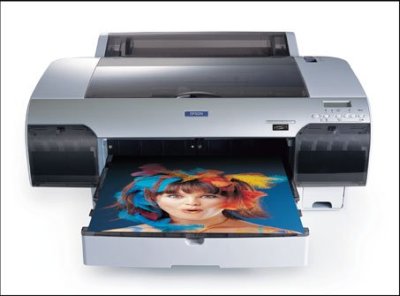articles/Digital/colouradjust7-page3
Colour Adjustment - Part 7 - part 3 of 1 2 3 4 5 6 7
by Mike McNamee Published 01/11/2003
Proofing from Adobe Products
The common colour architecture of the Adobe product range means that an image printed from Photoshop will match that same image printed from Illustrator, InDesign or Acrobat. However, to do so, the colour must be managed in an identical way from all applications.
A note of caution: please note that we are referring here to the creation of proofs which mimic press behaviour. This is NOT the same thing as printing pictures for a client's wedding album! For that you should print directly to your inkjet printer from an RGB file in the way you know and trust.

The latest Epson Stylus Pro 4000-PS has all the facilities for proofing at high precision and speed. See the review in this issue.
Application Set-up
For printing in the UK you should set-up your colour to use Europe Prepress Defaults (in Photoshop; Edit>Color Settings>Settings>Europe Prepress Defaults). This will give you Adobe RGB (1998) as your RGB colour working space and deliver better separations to CMYK, especially in the cyan part of the gamut. If you want or need the full low down on this see Martin Evening's Book on Photoshop 7 page 92 (available from HO at £29.99).
Next you should have available, profiles for your own printers and for the press you are trying to simulate. If you have neither, you can obtain profiles for your printer/paper combination from the manufacturers' web sites or pay to have then made as bespoke profiles for your own set-up. The latter course is the most accurate by some way. Your press people may be, as yet, unspecified or may not have profiles. Either way, you should talk to somebody ahead of deciding, even if it is only to a more experienced colleague! There are arguments for not profiling a CMYK press, but to provide average conditions and to this end, using the Photoshop SWOP or Euro Prepress defaults is OK for many jobs. Specifying a generic profile or even no profile for a CMYK job is less risky than not providing a profile with an RGB image. In the former you will still get close, in the latter anything can happen and frequently does! When choosing your CMYK settings you should decide between "coated" and "uncoated" paper stocks. This magazine is printed on coated stock, weekly magazines are often printed to lower quality, coated stock and newspapers are printed on uncoated stock. The quality degrades in the same order.
Please Note:
There is more than one page for this Article.
You are currently on page 3
- Colour Adjustment - Part 7 page 1
- Colour Adjustment - Part 7 page 2
- Colour Adjustment - Part 7 page 3
- Colour Adjustment - Part 7 page 4
- Colour Adjustment - Part 7 page 5
- Colour Adjustment - Part 7 page 6
- Colour Adjustment - Part 7 page 7
1st Published 01/11/2003
last update 09/12/2022 14:52:37
More Digital Articles
There are 0 days to get ready for The Society of Photographers Convention and Trade Show at The Novotel London West, Hammersmith ...
which starts on Wednesday 15th January 2025





